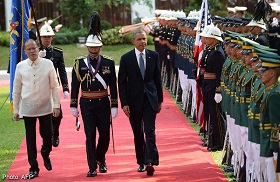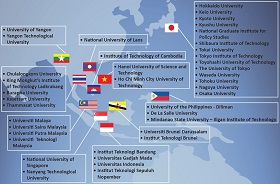Last Wednesday I delivered a paper on the issues and challenges facing the ASEAN Economic Community, which should be operational in 2015. I spoke guardedly of what lies ahead for the region given that goods, services, investment and skilled labor will transect 10 jurisdictions, rendering the usual attributes of the nation state all but obsolescent [1].
The Asia Pacific region is today a key focal point for the world’s three political and economic giants: the United States, China and India. It is home to over half the world’s 7 billion people, it originates over half the global output and is where nearly half the world’s trade is generated.
But the political and security environment casts something of a shadow over these optimistic trends. Rising tensions, aggression, and an increasing number of flashpoints threaten the stability and continuity that the ASEAN Economic Community needs as the basis for economic cooperation.
Analysts talk about a future troika of the ASEAN Economic Community, the ASEAN Security Community, and the ASEAN Sociocultural Community, but these entities are fundamentally intertwined, and cannot be decoupled.
Thus, we already see that trade between China and Japan is affected by increasing tensions resulting from rival claims over islands in the East China Sea. Recently, protesters in China took to the streets, overturning and burning Japanese-made cars in an action sparked by rising tensions between the two powers over the Senkaku/Diaoyou islands.
The geopolitical tensions have spilled over into the economic realm, with both countries reducing bilateral trade and other economic activities, further straining relations.
Similarly, in a recent trade fair in China where Philippine-made goods courted the Chinese market, many small entrepreneurs complained that their products were being held in Chinese ports. Citing various non-tariff-related issues such as labeling, food content and other requirements, the entrepreneurs complained that these measures prevented them from showing their products to the lucrative Chinese market and effectively dampened their chances of entering the market.
Last week a Chinese worker was killed and several factories were set on fire by Vietnamese protesters who reacted violently to China’s placement of rig in disputed waters in the East Asian Sea. Taiwanese factories were the prime target, and thousands of Chinese nationals were evacuated from Vietnam.
All this anecdotal evidence goes to show that, instead of the decoupling of economic and politico-security issues, they are, as suggested in the hypothesis above, very closely linked.
China’s recent announcement of an Air Defense Identification Zone (ADIZ) spanning disputed territories between China and Japan sparked protests from Japan, South Korea, the U.S. and the Philippines and was immediately tested. South Korea also declared and extended its ADIZ, which also encompasses disputed territories between South Korea and China.
Observers have expressed fears that the ADIZ could be the next flashpoint if genuine efforts to defuse the heightened tension are not successful.
There is a saying that goes: when elephants quarrel, as smaller creatures we have to be sure we are not crushed in the process.
Let us now describe what is happening in the region from the lens of its two powerful countries, each of which has claimed the region as within its sphere of influence.
The Unites States has long considered the Asia Pacific region as a key driver of world politics. The United States’ countless strategic moves to shape the security and economic architecture of the region are received differently across the region.
There are those states, such as the Philippines, which welcome enhanced cooperation with the United States, in part in response to China’s continued assertiveness in the contested South China Sea. President Obama recently visited the Philippines and signed an Enhanced Defense Cooperation Agreement (EDCA) with the country, which also covers non-military activities such as maritime security, disaster management, and other areas of cooperation between the two armed forces.
Not surprisingly. China views the EDCA as a hostile action, and has warned the United States not to interfere in regional matters. China has long favored bilateral over multilateral approaches to resolving disputes with its neighbors.
Then, there is South Korea and Japan, whose enhanced security cooperation and defense treaties with the United States form the basis for the presence of 50,000 U.S. troops on their territory. Vietnam also boasts enhanced military cooperation with the United States, allowing the latter to use its strategic ports for its naval vessels.
Then there is Australia and Singapore, traditional U.S. allies, whose ostensibly deep commitment to the same values allow them to engage the United States in deepening and widening military cooperation involving enhanced interoperability and joint exercises that go beyond basic combat operations.
Iraq and Afghanistan provided more motivation for the United States to pivot to Asia. U.S. leaders claim their country is both a Pacific power and an Atlantic power. The key to its economic development and their successful emergence from longstanding economic slowdown lies in the Asia Pacific.
It is not surprising that U.S. concerns in the region would include ensuring open sea lanes for communication and commerce, maintaining peace and security, countering North Korea’s nuclear plans, ensuring open markets and transparency in military activities.
The United States’ “forward deployment diplomacy” would include new bilateral security alliances or enhancing existing ones, engaging all countries in the region, including China, in multilateral platforms and keeping a credible military presence in the region to ensure that the business community has the stability it needs.
As noted earlier, U.S. treaty alliances with Japan, Australia, South Korea, Philippines and Thailand remain the “fulcrum” of the country’s strategic pivot to the region. Not surprisingly, China views this chain of alliances as containment, which adds to continued tensions in the area.
What about China?
Much has been said about China’s rise, which, unfortunately, has not yet been met with parallel actions on the ground. China continues to stress that it is not an expansionist power, but others in the region view its actions in the contested East and South China Seas as suggesting otherwise.
Key questions remain: what kind of aspiring superpower does China want to be? Is it the benevolent rising one as many in the region hoped?
China has already replaced the United States as the largest economy. However, it would seem that China is less happy with this distinction, as it fears it may be categorized as a developed economy, with all the concomitant responsibilities.
The continued stagnation of the U.S. economy and the intractable crisis in the European Union has impacted China’s dynamic growth in recent years. However, as the U.S. and EU markets wane, China is increasingly reliant on domestic consumption and its increasing exports to other parts of the world to fuel its economic growth. Many economists now warn of a real estate bubble that could burst and set China on a downward spiral not unlike what was seen with the United States’ subprime crisis in 2007.
China’s continued assertive actions in the contested South China Sea is not seen by other regional powers as engendering trust and confidence. Its show of force with its newly acquired aircraft carrier and skirmishes with rival claimants such as the Philippines, Japan and Vietnam over contested waters and changing borders of the East and South China Sea increase the temperature in the region and effectively also raise the sense of uncertainty.
A high level of uncertainly would not benefit any plans for cooperative economic activity. So, while the ASEAN Economic Community and the ASEAN Security Community have differing timelines, it would appear that they are fundamentally interlinked.
Will economics trump politics? We just do not know... But we do know that more people to people exchanges, increasing cooperation among marine scientists, academics, students and research institutes or think tanks fuel more robust cooperation that has good prospects of expanding in both scope and level.
This is the functional route to regional cooperation. Analysts hope that largely non-political areas of cooperation like science and technological exchanges, cultural and social interaction engender “habits of cooperation” which are long lasting and which deliver “shared impact.”
The hope is that these areas of cooperation will, over time, spillover into more political areas once a consensus on conflict management has been reached.
The “Fulbright effect” is also a very important component of people to people exchanges. The thousands of Chinese students studying in the United States and an increasing number of Americans and Southeast Asians studying in China may be seen as something akin to “force multipliers,” as these numerous interactions could eventually pave the way for the resolution of seemingly intractable conflicts.
The ASEAN University Network is one of the critical first steps to regional integration. While the economic train seems to be the key driver in ASEAN’s pursuit of regional integration, as a scholar, I believe that it is thinking alike, shared values, and respect for differences, which are key features of academia, that will foster the broader sense that we are all part of one shared space.
Thus, security can be both graduated and divisible in a large sense. Economics, politics, and security are so deeply intertwined that it may be a grave error in judgment for any regional power to believe that it can continue to pursue an assertive course of action in this latter sphere, while continuing to win global market share.
1.Based on a paper presented at the ASEAN Center MGIMO, Moscow, Russia on May 22, 2014.






